Microwaving cat food involves heating it quickly in a microwave oven. It’s not recommended as it can change the food’s texture and nutrient composition. The heat can create hot spots, burning the food or causing uneven heating, which can harm your cat. It’s safer to warm cat food by using room temperature or warm water instead of microwaving it.
Are you wondering, Can You Microwave Cat Food? The microwave, a time-saving kitchen tool, might seem convenient for warming up your feline friend’s meal. But hold on! Before you hit that start button, let’s explore whether zapping your cat’s food in the microwave is actually safe and healthy for your furry companion.
When it comes to Can You Microwave Cat Food? The concern revolves around the safety and nutritional integrity of your cat’s meal. Stay with us to understand why microwaving might not be the best option for your feline friend’s food, and discover alternative ways to ensure their meal is both safe and delicious.
Why Do You Never Microwave Cat Food?
Microwaving cat food alters its texture and nutrients, potentially harming your cat’s meal. The heat can create hot spots, burning or unevenly heating the food, risking your cat’s health. Microwaves don’t evenly distribute heat, making it risky for ensuring safe temperatures in cat food.
Microwaving can lead to nutrient loss, affecting the food’s overall nutritional value. It’s crucial to prioritize your cat’s well-being by opting for safer methods to warm their food, such as using warm water or letting it reach room temperature naturally.
Should You Warm Up Refrigerated Cat Food?
Warming refrigerated cat food might seem like a good idea, but it’s not always necessary. Cats generally prefer their food at room temperature, so you can simply let it sit out for a bit before serving. If your cat prefers warmer food, use warm water or place the food container in warm (not hot) water for a few minutes to take the chill off.
Microwaving refrigerated cat food isn’t ideal as it can create hot spots and alter the food’s texture. Plus, it might destroy some of the essential nutrients. Keeping it simple by letting it naturally reach room temperature or gently warming it without a microwave is usually the best way to go.
Can Cold Food Make Cats Sick?
Cold food might upset a cat’s stomach, potentially leading to sickness. Cats prefer their food at room temperature or slightly warmer. Cold meals can cause discomfort, leading to digestive issues or reluctance to eat.
Introducing cold food suddenly might disturb a cat’s digestive system. It’s important to let refrigerated food warm up a bit before serving it to your cat. Ensuring their meal is at a comfortable temperature can help prevent any potential stomach upset or reluctance to eat.
How Long To Microwave Cat Food?
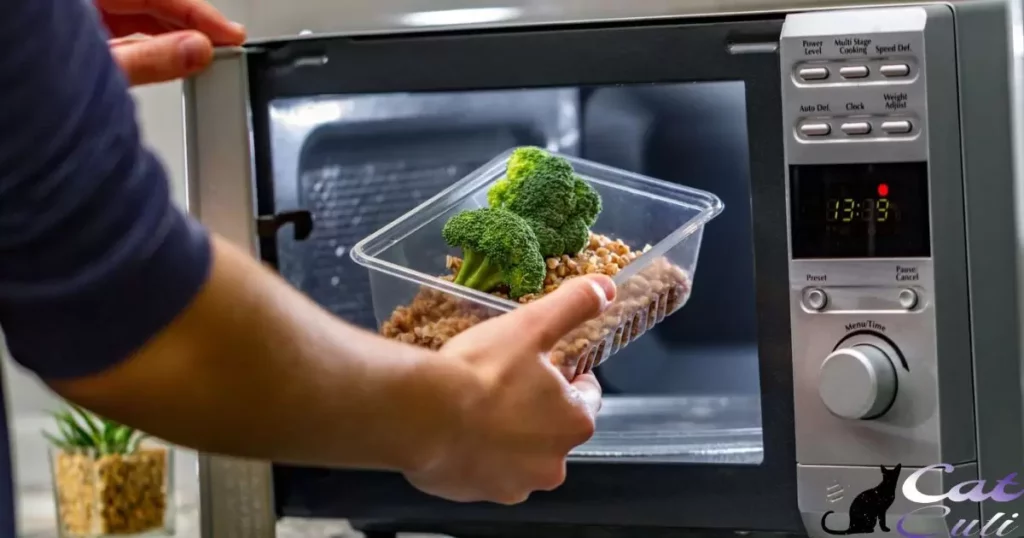
Microwaving cat food depends on its quantity and type. For a single serving, start with 10-15 seconds on medium heat, stirring halfway through. Adjust the time based on your microwave’s power, aiming for a warm but not hot meal for your cat. Always check the temperature before serving to prevent any burns.
The exact time varies; wet food heats faster than dry. Typically, 5-10 seconds suffices for a small portion of wet food. For larger amounts or to reach the desired temperature, add a few seconds at a time, stirring to ensure even heating. Keeping a close eye helps prevent overheating and maintains the food’s quality for your feline friend’s enjoyment.
How To Warm Up Cat Food Without Microwaves?
Warming cat food sans microwaves is simple. One method involves placing the food container in a bowl of warm water for a few minutes. Another way is to let it sit at room temperature for a bit before serving. These methods ensure your cat’s meal is warmed evenly and retains its nutrients, without the need for a microwave.
Utilizing small, heat-safe dishes and slowly warming the food on the stove can also do the trick. This approach allows for careful monitoring of the temperature, ensuring it’s just right for your feline friend’s sensitive plate.
3 Warm Up Tips For Your Cats Meal
- Warm Water Bath: Place the cat food container in a bowl of warm water for a few minutes to gradually raise its temperature without altering its texture or nutrients.
- Room Temperature: Let the cat food sit at room temperature for a short while before serving, ensuring it’s not too cold for your feline friend.
- Stove Warming: Use small, heat-safe dishes and warm the cat food on the stove over low heat, allowing for careful temperature control and even heating.
Should I Heat Up Wet Cat Food?
Heating up wet cat food can make it more enticing for your furry friend. It enhances the aroma and brings out the flavours, which some cats prefer. Avoid microwaving it directly; instead, opt for warming it by placing the sealed pouch or can in warm water for a few minutes.
Not all cats prefer warmed food, so observe your pet’s preference. Heating the wet cat food slightly can enhance its appeal without compromising its nutritional value, offering your cat a satisfying meal.
Why Should You Warm Up Wet Cat Food?
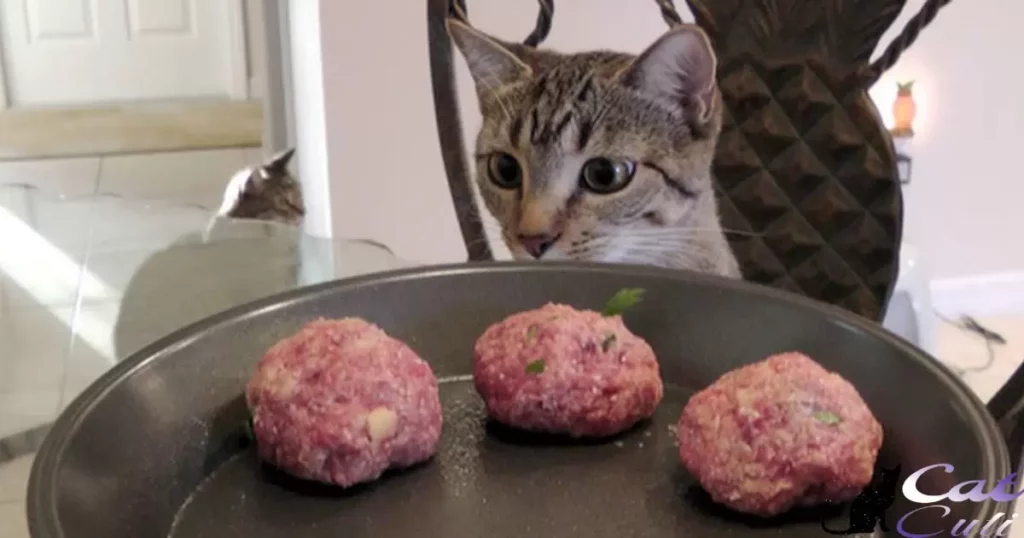
Warming up wet cat food can make mealtime more enticing for your feline friend. It enhances the aroma, bringing out the flavours that might otherwise stay muted when served cold. Cats often prefer their food at room temperature or slightly warmed, making it more appealing and easier for them to digest.
When you warm up wet cat food, it helps release enticing scents that can stimulate your cat’s appetite, especially for picky eaters. Plus, slightly warming the food can mimic the natural temperature of freshly caught prey, catering to your cat’s instincts and making the meal more satisfying for them.
Why You Shouldn’t Heat Up Wet Cat Food?
Heating wet cat food might seem helpful, but it can change its texture and nutrient value. Heating alters the food’s composition, potentially affecting your cat’s health. Hot spots can form, making parts of the food too hot and unsafe for your cat to eat.
It’s better to serve wet cat food at room temperature to maintain its nutritional quality and ensure your cat’s safety and enjoyment.Heating up wet cat food alters its texture and nutrient content, which could harm your cat’s health.
Uneven heating can create hot spots, making parts of the food too hot for your cat to consume safely. To maintain the food’s nutritional value and keep your cat safe, it’s advisable to serve wet cat food at room temperature rather than heating it up.
Serving Warmed Up Wet Cat Food?
When warming wet cat food, it’s best to avoid using the microwave. Instead, opt for warming it in a bowl of warm water for a few minutes. This ensures the food is gently heated without compromising its texture or nutrients.
Another method is to let the food sit at room temperature for a bit before serving it to your cat. This allows it to reach a comfortable temperature without the need for microwaving, ensuring your cat enjoys their meal without any potential harm from uneven heating.
The Risks Of Microwaving Your Cat’s Food
Microwaving your cat’s food poses risks as it can create hot spots, potentially burning the food and altering its nutrients. Heating unevenly might lead to an unbalanced meal for your feline friend. This method can also change the food’s texture, making it less appetizing or even harmful for your cat’s digestion.
Microwaving cat food might cause loss of certain vitamins and minerals crucial for your cat’s health. The rapid heating process can break down essential nutrients, impacting the overall nutritional value of the meal. It’s essential to consider safer alternatives to preserve the quality and nutritional content of your cat’s food.
Can You Put Cat Food In The Microwave?
Microwaving cat food isn’t recommended. Heating cat food in the microwave can create uneven temperatures, potentially burning parts of the meal. It may also alter the food’s texture and nutrient content, impacting its nutritional value for your cat.
It’s safer to warm the cat food using other methods, like adding warm water or letting it sit at room temperature for a bit before serving it to your feline friend.When considering whether to put cat food in the microwave, it’s important to prioritize your cat’s safety and nutrition.
Avoiding the microwave helps maintain the quality of the food, ensuring your cat gets the best meal possible. Opt for gentler warming techniques to preserve the nutritional goodness of the food and keep your cat healthy and happy.
Don’t Let Your Cat Suffer: Make Sure The Food Is Hot Enough
Ensure your cat’s food is sufficiently hot to prevent discomfort. Cats prefer warmer food, so heat it adequately before serving. This simple step ensures your furry friend enjoys their meal without any discomfort.
Avoid letting your cat’s food get too cold. Heating it adequately makes mealtime more enjoyable for your feline companion. Ensuring the food is warm enough helps prevent any potential discomfort for your beloved pet.
Is It Ok To Warm Up Canned Cat Food?

Warming up canned cat food can be okay as it enhances the aroma and may make it more appealing for your cat. You can warm it by placing the sealed can in warm water for a few minutes or using a microwave for a short duration. Be cautious not to overheat the food as it might destroy nutrients or create hot spots that could burn your cat’s mouth.
Always stir it well and test the temperature before serving to ensure it’s comfortably warm for your feline friend.While warming canned cat food is generally fine, avoid prolonged heating or high temperatures as it might alter the food’s nutritional content.
Quick and gentle warming methods preserve the taste and quality, making the meal more enticing for your cat. Moderation and careful monitoring of the food’s temperature are key to keeping it safe and enjoyable for your pet.
How To Serve Your Cat Canned Food?
When serving your cat canned food, remember to use a clean dish to avoid any contamination. Gently scoop the desired portion into your cat’s bowl, ensuring it’s at room temperature or slightly warmed. This helps enhance the aroma, making it more appealing to your feline friend.
Another tip is to cover and refrigerate any leftovers promptly. Opened cans should ideally be sealed and stored in the fridge for no more than a day or two to maintain freshness. Keeping these simple steps in mind ensures your cat enjoys a safe and tasty meal every time you serve canned food.
Should You Heat Up Your Cats’ Food?
Warming your cat’s food might seem like a good idea, but it’s not always necessary. Cats generally prefer food at room temperature, so heating it up isn’t essential. If you decide to warm their meal, use warm water or let it sit for a while instead of using the microwave, as this can alter the food’s nutrients and texture.
When considering whether to heat your cat’s food, keep in mind that microwaving can create hotspots that might burn the food or make it too hot for your cat’s sensitive mouth. Heating can also destroy some of the nutrients present in the food. It’s best to check the temperature and avoid making it too hot to ensure your furry friend enjoys their meal comfortably.
Should Cat Food Be Cold Or Warm?
Cat food is better served at room temperature or slightly warm. Cold food might not appeal to your cat’s taste buds and can be less palatable. Warming it slightly can enhance the aroma and make it more enticing for your furry friend.
Avoid making it too hot as it can burn your cat’s mouth. Aim for a gentle warmth by using warm water or briefly microwaving the food, ensuring it’s not too hot before serving it to your cat. Finding the right temperature can make mealtime more enjoyable for your feline companion.
How Do You Heat Up Cold Cat Food?
When it comes to heating up cold cat food, opt for simple methods like using warm water or allowing it to sit at room temperature. Placing the food in a bowl and immersing it in warm water for a few minutes can gently warm it without compromising its nutrients.
Leaving the food out for around 20-30 minutes to reach room temperature is a fuss-free way to make it more palatable for your feline friend.Microwaving cold cat food isn’t the best choice, as it can create uneven heating and alter the food’s texture.
By avoiding the microwave, you’ll ensure that your cat’s meal maintains its nutritional value and remains safe for consumption. Stick to gentler warming methods to keep your cat’s food both safe and appetizing.
How Long To Microwave Cat Food?
Microwaving cat food depends on the amount and type. For a small serving in a microwave-safe dish, start with 10-15 seconds. Increase in 5-second intervals until warm but not hot. Be cautious; microwaves vary, and hot spots can burn the food.
Avoid overheating, which may destroy nutrients. Stir the food well after microwaving for even temperature distribution. Always test the temperature before serving to ensure it’s just right for your cat’s sensitive palate.
Is It Safe To Microwave Your Cat’s Food?
| Safety Considerations | Explanation |
| Uneven Heating | Microwaves can create hot spots, leading to unevenly heated food. |
| Nutrient Loss | Overheating may destroy essential nutrients in the cat food. |
| Burns or Hot Spots | Careless microwaving can result in burning or excessively hot areas. |
| Testing Temperature | Always test the food’s temperature before serving it to your cat. |
Remember, while microwaving cat food is possible, it’s important to do so cautiously to avoid potential risks to your cat’s health.
How To Warm Cat Food Without Microwave?
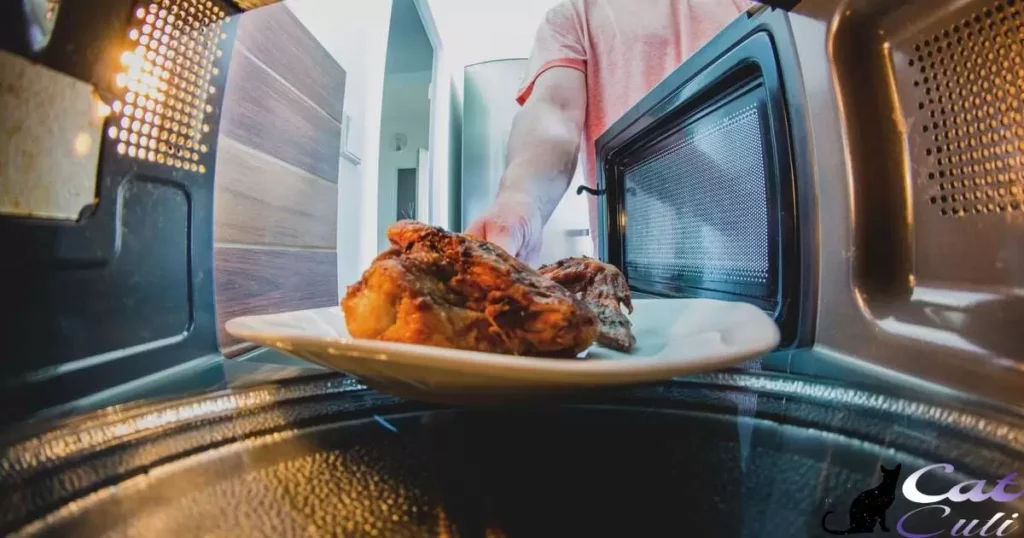
Warming cat food without a microwave is simple! One way is by placing the food in a bowl, then setting that bowl in a larger container filled with warm water. Another method involves using a warm plate: just pour the cat food onto the plate and let it sit for a few minutes before serving.
Both techniques gently warm the food without compromising its nutrients or texture, ensuring a happy mealtime for your feline friend.Microwaves aren’t the only option for warming your cat’s food! By employing these easy, microwave-free methods, you can warm your cat’s meal gently and safely.
How Long Are Canned Goods Safe In The Heat?
Canned goods last well in the heat for a while, but extreme temperatures can shorten their shelf life. High temperatures, like those in a car on a hot day, speed up the breakdown of canned food. Ideally, store canned goods in a cool, dry place to maintain their quality and safety.
It’s essential to check canned goods regularly, especially if they’ve been exposed to heat. Inspect cans for any signs of damage, like bulging, leaks, or unusual odours, as these might indicate spoilage. Keeping an eye on storage conditions helps ensure the canned goods stay safe to eat for longer periods.
Do Cats Like Their Food Cold Or Warm?
Cats generally prefer their food at room temperature or slightly warm. They’re more inclined to eat food that’s not too cold or hot. Offering food that’s too cold might put them off, while overly hot food could burn their sensitive mouths.
Cats tend to enjoy meals that are closer to their body temperature, making it more appealing for them to eat and enjoy their mealtime.It’s important to find the right balance when serving your cat’s food to avoid extremes of temperature.
You can warm their food slightly to enhance its aroma and make it more enticing, but always test it to ensure it’s not too hot before serving it to your feline companion. This way, you can keep your cat happy and satisfied during mealtime.
Is Cold Wet Cat Food Bad For Cats?
Cold wet cat food isn’t inherently bad for cats. Cats often prefer food at room temperature, so serving it cold might lead to them eating less. It doesn’t pose any health risks; it’s more about your cat’s preference. To ensure they eat well, consider letting the food sit out for a bit to warm up slightly before serving.
It’s important to note that while cold wet food isn’t harmful, excessively cold temperatures might make it less appealing to your cat. They might enjoy their meal more if it’s closer to room temperature. Keeping an eye on their preference and making small adjustments in serving temperature can ensure they eat happily.
Can You Leave Wet Cat Food Out Overnight?
Leaving wet cat food out overnight poses risks. Bacteria can multiply rapidly in moist food at room temperature, causing spoilage and potential health issues for your cat. It’s crucial to refrigerate any uneaten wet cat food within 1-2 hours to maintain freshness and prevent bacterial growth. Leave Wet Cat Food Out requires proper handling to ensure your cat’s safety.
If left out overnight, wet cat food can become unsafe for consumption. The warmer room temperature creates a breeding ground for bacteria, potentially causing stomach upsets or more serious health problems for your cat. Storing wet cat food properly in the refrigerator helps preserve its quality and keeps your furry friend safe and healthy.
Does Eating Refrigerated Food Bad For Cats?
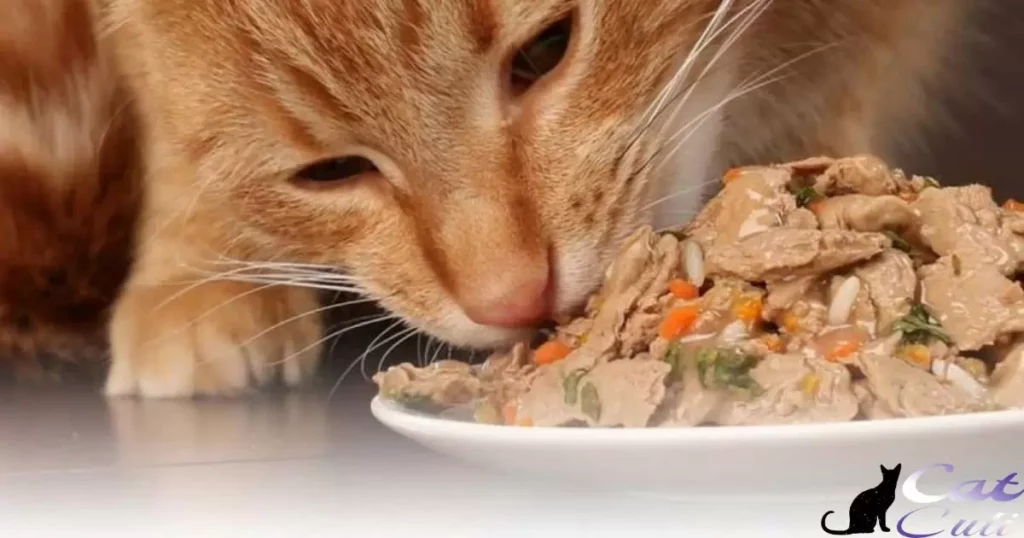
Refrigerated food isn’t necessarily bad for cats, but it’s vital to be cautious. Eating refrigerated food might upset a cat’s stomach if it’s been stored for too long or isn’t fresh. Cats are sensitive to spoiled food, so it’s crucial to check for any signs of spoilage before offering it to them.
Always check the expiration dates and the food’s condition before serving it to your cat. Refrigeration helps preserve food, but if it’s gone bad, it could lead to digestive issues for your furry friend. Opt for fresh or properly stored refrigerated food to ensure your cat stays healthy and happy.
Is It Okay To Use The Microwave To Warm Up Cat Food?
Using the microwave to warm cat food seems quick, but it might alter the nutrients and texture. Heating cat food in the microwave can cause uneven temperatures, potentially harming your cat’s meal. It’s safer to warm the food using warm water or letting it reach room temperature naturally.
Microwaving cat food raises concerns about changing its nutritional value and texture. The microwave’s heat can create hot spots, leading to uneven heating that might not be safe for your cat. Instead, opt for gentler warming methods like using warm water or letting the food naturally come to room temperature.
Can You Microwave Dry Cat Food?
Microwaving dry cat food isn’t advisable. Heating it in the microwave can cause uneven temperatures, potentially creating hot spots that might burn or alter the food. This could lead to a loss of nutrients and affect its taste, making it less appetizing for your cat.
Opt for room temperature or slightly warm water to enhance the food’s palatability without compromising its nutritional value. When considering microwaving dry cat food, remember it’s not the best choice.
The microwave’s intense heat can change the food’s structure and reduce its nutritional content. To ensure your cat enjoys a wholesome meal, explore alternative ways to gently warm the food without using the microwave, preserving both its taste and nutritional goodness.
How To Warm Cat Food Without Microwaves?
Warming cat food without a microwave is easy! Firstly, opt for room temperature food or place the sealed container in warm water for a few minutes. Another method involves using warm water to create a makeshift double boiler. Just put the food in a bowl, then place that bowl in a larger one filled with warm water.
Consider using ceramic or stainless steel bowls for microwaving alternatives. These materials retain warmth and can help keep the food at an optimal temperature for your cat. By avoiding microwaves, you’re ensuring that your feline buddy enjoys their meal in the healthiest way possible.
How To Warm Up Cat Food?
Warming up cat food is easy. Use a microwave-safe dish to heat the food for about 10-15 seconds. Stir it well to ensure an even temperature. Place the food container in warm water for a few minutes to gently warm it up. Remember, never microwave cat food for too long or serve it hot to prevent any harm to your furry friend.
Another way to warm cat food is to let it sit at room temperature for around 30 minutes before feeding time. This method maintains the food’s texture and nutrients without the need for any heating tools. Simply cover the food to protect it from dust or insects while it warms up. It’s a simple and effective way to ensure your cat enjoys their meal.
Cat Food Sparking In Microwaves?
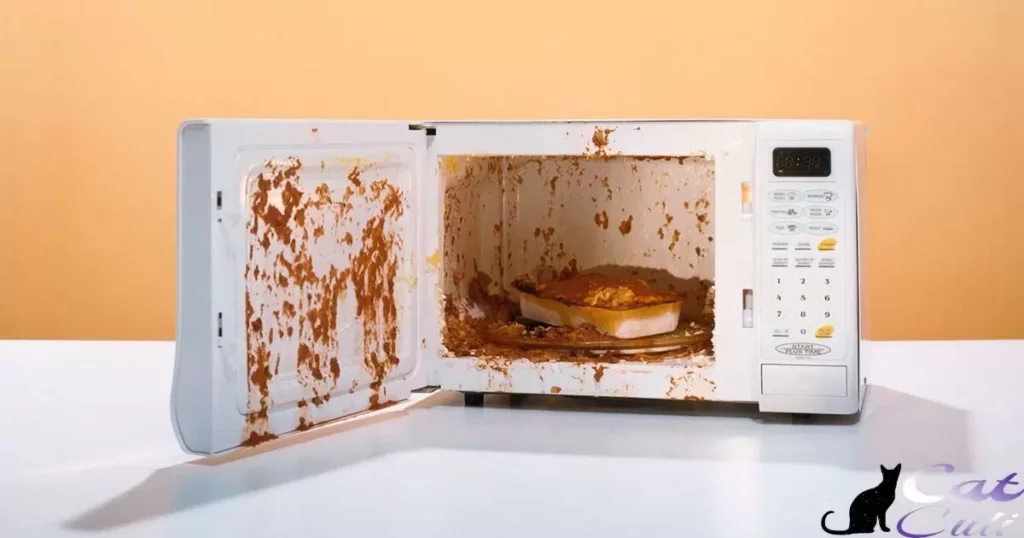
Cat food sparking in microwaves can happen when there are metallic elements or foil in the packaging. These metals can cause arcing, leading to sparks and potential damage to the microwave. It’s crucial to transfer the cat food to a microwave-safe dish before heating to prevent sparking incidents.
To avoid any mishaps, always check the packaging for any metal components before microwaving cat food. Using microwave-safe dishes specifically meant for heating pet food can ensure a safe and hassle-free experience without the risk of sparking or damaging your microwave.
Do Cats Like Their Food Warmed Up?
Cats often prefer their food at room temperature or slightly warmed. Warming their food can enhance the aroma, making it more appealing to them. Some cats might show a preference for warmed food, especially if they are used to it from kittenhood.
Cats have sensitive noses, so serving slightly warmed food can intensify the scent, making it more enticing and appetizing for them.It varies from cat to cat. While some adore warmed meals, others might not have a preference and are content with food straight from the can.
It’s essential to observe your cat’s reactions to warmed food to determine their preference. Offering both room temperature and slightly warmed options can help you understand what your feline friend enjoys most at mealtime.
FAQ’s
Is it OK to microwave dry cat food?
Microwaving can alter nutrients and texture. It’s best to avoid as it might create hot spots, potentially harming your cat.
Is it OK to cook cat food?
Cooking cat food alters nutrients; consult a vet or use recipes designed for cat nutrition to ensure it’s safe and balanced.
Are cats allowed warm food?
Yes, cats often prefer slightly warmed or room temperature food. It enhances aroma, making it more appealing to them.
Conclusion
Can You Microwave Cat Food? The key lies in understanding the potential risks and alternatives. Microwaving cat food might seem convenient, yet it can alter the food’s nutrients and texture, posing potential health risks for your feline friend.
Opting for safer methods, such as warming food with warm water or serving it at room temperature, preserves the nutritional value and reduces any risks associated with microwaving. While cats often prefer slightly warmed food, observing their preferences and ensuring their meals are safe and nutritious should remain the priority.








